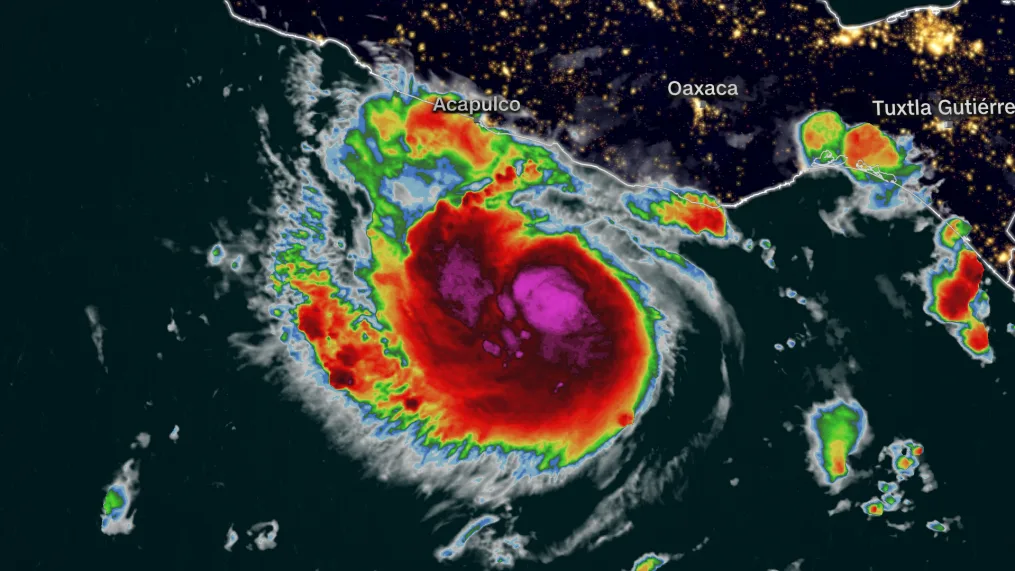(CNN) — Otis wasn’t predicted to become a hurricane until early Tuesday, more than 24 hours after it made landfall at unprecedented Category 5 strength.
A hurricane watch was issued Monday afternoon for Acapulco and surrounding coastal areas in Mexico’s Guerrero province. Michael Brennan, director of the National Hurricane Center, told CNN that the forecasts were “on the high side of almost all of the extreme guidance” that forecasters get from computer models.
But the system is still vastly underrated. Satellite data and hurricane models underestimate Otis’ intensity and how strong it will become, Brennan said.
High winds were expected to keep Otis’ force at bay. But it’s a small storm that’s more prone to big changes in intensity. As Tuesday progressed and the storm began to move into incredibly warm waters near the coast, it became clear that environmental conditions were not playing out as forecasters had expected and that Otis was not going to retreat.
Experts from the National Hurricane Center used satellites to assess Otis’ intensity, a common practice for tropical systems, but this method can cause problems.
Michael Brennan, director of the National Hurricane Center, told CNN: “We don’t have the best complete picture of what’s going on beneath the cloud layer that you see in satellite images.”
That’s where Hurricane Hunters, NOAA’s aerial reconnaissance team, come into play. Airplanes drop sensors into the storm to take real-time readings as they pass through the hurricane, including wind speed and pressure.
“Then we had a Hurricane Hunter plane flying through the storm [el martes] By late afternoon, the data revealed that the storm was 30 to 50 km/h stronger than we estimated from satellite imagery,” Brennan told CNN.
Brennan said the NHC typically sends reconnaissance planes to the eastern Pacific for “hurricane threats to land areas.” CNN asked Brennan why he didn’t send hurricane hunters into the storm before Tuesday afternoon.
Flight data confirmed that Otis had begun to rapidly intensify and the storm forecast had changed dramatically.
“It’s always the worst situation when you have a storm [intensificándose rápidamente] “So close to a landslide, when you have to make significant upward changes in the forecast, the reality of the situation that people are going to face is very different than what they initially planned for,” Brennan told CNN.
That’s how intense the storm was this Tuesday. All times correspond to Mexico City time.
Tropical Storm Otis moves off the coast of Mexico after 6 a.m. CDT on Tuesday, October 24.
Tuesday:
- 3 am, Tropical Storm 104 kmph: The NHC has forecast a hurricane for the first time and says it has a “1 in 4 chance of rapid strengthening in the next 24 hours.”
- 9 am, Tropical Storm 112 kmph: The NHC raises its extreme forecast slightly, saying some forecast models show a “higher than normal probability” of rapid intensification and that “a further upward adjustment to the extreme forecast is possible later today.”
- 12 noon, Category 1 Cyclone at 128 kmph: Hurricanes enter very warm waters off the coast of Mexico and quickly begin to intensify, aided by moist air and favorable winds at high levels, two factors that allow hurricanes to strengthen. “It will strengthen to landfall,” the hurricane center warned.
- 1 to 2 PM: Hurricane hunters flew through the eye of Otis and discovered it was much stronger than satellites had estimated.
- 3 pm, Category 3 Cyclone 200 kmph: The NHC drastically revised its intensity forecast, declaring an “extremely dangerous” Category 4 hurricane with sustained winds of 225 km/h just before landfall.
- 6 pm, Category 4 Cyclone at 230 kmph: The NHC warns “… there are no signs of this eruption slowing down,” and predicts Otis will reach Category 5 for the first time.
- 9 pm, Category 5 cyclone with speed of 250 kmph: The hurricane center warns “a dire scenario is unfolding over southern Mexico tonight as rapidly intensifying Otis approaches the coast.”
Wednesday:
- 12:25 am: Otis makes landfall as a 165 mph Category 5 hurricane.
Before Otis, no Category 5 hurricane had made landfall in the eastern Pacific, according to the NOAA hurricane database.
The previous strongest hurricane to make landfall was Hurricane Patricia in 2015, which made landfall as a Category 4 hurricane with sustained winds of 150 mph.





